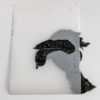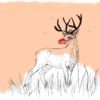Myths is a recurring theme in Russian born Julia Mordvinova Gilje’s work. The classical stories of ancient Greece and The Middle Ages fascinates her and serves as a Sarepta’s Jar of inspiration. In a newly opened exhibition in Stavanger (NO) examples of her mythical works are on display, as well as a series of small paintings reflecting on isolation and loneliness.
Appropriately, Gilje has named the exhibition «Myths». The show is to a large extent based upon her illustrations from the art book «Golden Myths of Ancient Greece». Her book projects have been a painstaking work, which took her a full ten years to complete. The books are all handmade, from writing and illustrations to the embossing of the leather binding. They are unique and fantastic works of art, which have been presented both nationally and internationally.
Gilje’s looks in particular at how the Greek myths portray relationships between gods and humans and how they describe relationships of power and love between feminine and masculine forces.
Several of the works are printed in gold on black paper. They look luxurious and one can’t help associating them with ancient Greek vase paintings. Gilje has also chosen to use gold in her painting of Persephone, and thus suggests a connection to religious motifs, for example in church art.
The Greek myths are well known, both from literature and from art history. The ones Gilje has selected are stories about erotic temptations and relationships between gods, nymphs and humans. Se has also chosen to look at some transformations. For example, from god or man to animals, plants, clouds or rain of gold.
But why using to – three thousand years old stories as motifs in contemporary art, and in what way are they relevant today? Maybe because myths – like the parables in the Bible – tell something basically about being a human. They tell about the strengths and weaknesses we possess, and what forces we are fighting – from inside and outside of us.
Myths are universal and valid at all times.
Let us take example in the story of Persephone and Hades. Persephone was the daughter of the fertility goddess Demeter and the god Zeus. As a young woman, she is abducted by Hades, the ruler of the underworld. As punishment, Demeter allows all life on earth to wither and die, until Hades realizes that he must let go of Persephone. This he does not do without resistance, and he enters a settlement with Demeter, where Persephone is allowed to enter the world of her mother part of the year but must live in the underworld the rest of the time. When Persephone threads upon earth, all that lives grows and the earth is fertile, while it withers and dies when she rests in the underworld.
The story of Persephone and Hades is thus not just a story of an abuser, a victim and a grieving mother. It is a poetic explanation of how the seasons came to be and a reminder that everything that lives has a cycle.
The Greek myths can thus be read on several levels and the erotic aspect is important. Not only because it is about desire and unwillingness, voluntariness and coercion, but also because it is about basic preconditions for life and creating.
Still. At first reading, many of the erotic myths appear as stories of masculine abuses of the feminine and it may be tempting to interpret them into a Me-to perspective. But in close reading of the stories, we see a balance and an emphasis and recognition also of women’s abilities, independence and drive.
Maybe this is the reason why Gilje in her Persephone painting has chosen to portray a woman in her own right? A girl who chooses the underworld voluntarily. For in this picture she is not a victim, but a young woman who leaves her family to live her own life, with the joys and dangers it may bring.
As written, there is another series of motifs in this exhibition; loneliness and isolation. In a small group of paintings, Gilje has reflected on this basic aspect of being human.
The knowledge humans have of having limited time may be a strength, but it also isolates us. The potential loneliness this entails is expressed in Julia’s art, and resonates in the loneliness many of us have felt these days when we have found our lives limited by Covid – 19, that small and invisible danger. It may not be easy but feeling lonely may also be a state of mind in where we can gather our recourses and find strength.
Gilje invites you to reflect on what the old myths really want to tell us and in what ways they are relevant to us today. We also invite you to see the beauty of her works, because as a classically educated artist, Gilje places great emphasis on both the craftsmanship and the aesthetics in her work.
View more of Gilje’s works
No 18 Kulturkafè
Skagen 18 Stavanger (NO)
Open Monday – Saturday 11.00 – 16.00 hrs.




